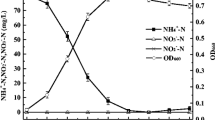Abstract
Effects of the inhibitors dicyandiamide (DCD), nitrapyrin (N-Serve, NS), and thiourea (TU) on growth and metabolism ofNitrosomonas europaea were tested under laboratory conditions. Growth of a pure culture was completely suppressed by 10 ppm NS and 0.5 ppm TU; inhibition by 300 ppm DCD was 83%. Ammonia oxidation and respiration of Nitrosomonas cell suspensions were reduced by 93% (10 ppm NS), 95% (0.5 ppm TU), and 73% (300 ppm DCD).
Hydroxylamine oxidoreductase was not affected by high concentrations of inhibitors (200 ppm DCD, 100 ppm NS, 100 ppm TU). Cytochrome oxidase activity was increased by 10% with 200 ppm DCD, not affected by 100 pm TU, and inhibited by 52% with 100 ppm NS.
The modes of action thus differed among the tested inhibitors. The merely bacteriostatic effect of dicyandiamide was demonstrated by the reversibility of growth inhibition.
Similar content being viewed by others
References
Amberger A (1986) Potential of nitrification inhibitors in modern N-fertilizer management. Z. Pflanzenern u Bodenkde 149: 469–484
Beck TH (1979) Die Nitrifikation in Böden. Z. Pflanzenern u Bodenkde 142: 344–364
Bundy LG and Bremner JM (1973) Inhibition of nitrification in soils. Soil Sci Amer Proc 37: 396–398
Campbell NER and Aleem MIH (1965) The effect of 2-chloro-6-(trichloromethyl) pyridine on the chemoautotrophic metabolism of nitrifying bacteria. J. Microbiol Serol 31: 124–144
Gasser JKR (1970) Nitrification inhibitors — Their occurrence, production and effects of their use on crop yields and composition. Soil Fertil 33: 547–554
Goring CAJ (1970) Control of nitrification by 2-chloro-6-(trichloromethyl) pyridine. Soil Sci 93: 211–218
Hauck, RD (1984) Nitrification inhibitors — potential and limitations. VDLUFA-Schriftenreihe 11: 9–21
Jensen HL and Sörensen H (1952) The influence of some organic sulphur compounds and enzyme inhibitors on Nitrosomonas europaea. Acta Agr Scand 2: 295–304
Jung J and Dressel J (1978) Umsetzungsvorgänge und Inhibierungsmöglichkeiten bei Boden- und Düngerstickstoff. Landw Forsch 31: 74–89
Lowry OH, Rosenbrough NJ, Farr AL and Randall RJ (1951) Protein measurement with the Folin phenol reagent. J. Biol Chem. 193: 265–275
Mahli SS, Cook FD and Nyborg M (1979) Inhibition of nitrite formation by thiourea in pure cultures of Nitrosomonas. Soil Biol Biochem 11: 431–432
Nuti MP, Neglia RG and Verona O (1975) Azione del solfato di diciandiamidina sul metabolismo chemoautotrofo di Nitrosomonas europaea. L'agriccultura (Italiana) 104: 219–225
Prosser JI and Cox DJ (1982) Nitrification. In: Experimental microbial ecology (EDS.: Burns RG and Slater JH) 178–193
Wood LB, Hurley BJE and Matthews PJ (1981) Some observations on the biochemistry and inhibition of nitrification. Water Res 15: 543–553.
Author information
Authors and Affiliations
Rights and permissions
About this article
Cite this article
Zacherl, B., Amberger, A. Effect of the nitrification inhibitors dicyandiamide, nitrapyrin and thiourea onNitrosomonas europaea . Fertilizer Research 22, 37–44 (1990). https://doi.org/10.1007/BF01054805
Received:
Accepted:
Issue Date:
DOI: https://doi.org/10.1007/BF01054805




